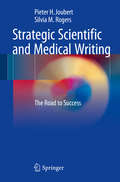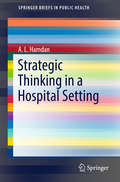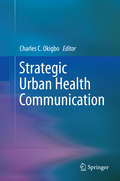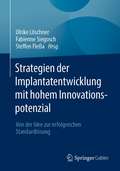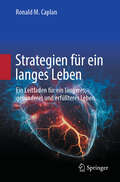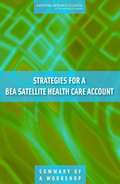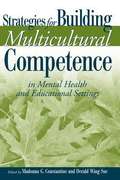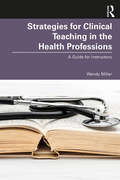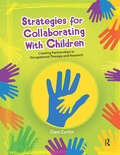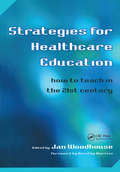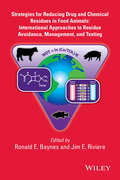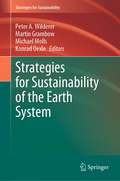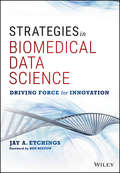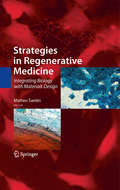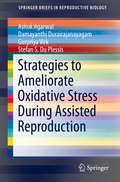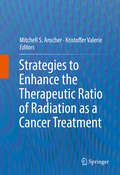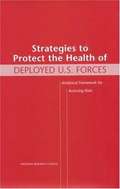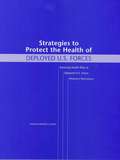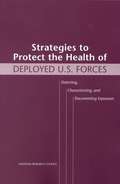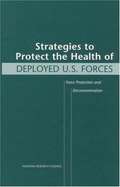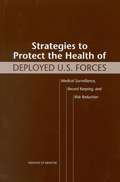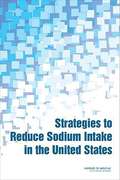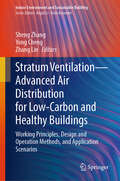- Table View
- List View
Strategic Scientific and Medical Writing
by Silvia M. Rogers Pieter H. JoubertA document may be based on accurate medical and scientific information, follow guidelines precisely, and be well written in clear and correct language, but may still fail to achieve its objectives. The strategic approach described in this book will help you to turn good medical and scientific writing into successful writing. It describes clearly and concisely how to identify the target audience and the desired outcome, and how to construct key messages for a wide spectrum of documents. Irrespective of your level of expertise and your seniority in the pharmaceutical, regulatory, or academic environment, this book is an essential addition to your supporting library. The authors share with you many years of combined experience in the pharmaceutical and academic environment and in the writing of successful outcome-driven documents.
Strategic Thinking in a Hospital Setting
by A. L. HamdanTranslating the realities of healthcare reform and healthcare costs into competitive hospital practice is the goal of this accessible, jargon-free guide. Taking its cue from Michael Porter’s highly-regarded business strategies, it offers a sound framework for hospitals looking to develop efficient, patient-centered service delivery, identifying keys to clinical, administrative, and marketing success. The book organizes business and clinical priorities where they intersect so that physicians throughout healthcare systems can understand their role in building and sustaining innovation, and leverage their strengths and system resources toward meeting patient needs. In addition, chapters review eight core strategic tools, describe possibilities for their implementation, and provide in-depth findings on Porter’s methods as used in a diverse group of hospitals across Lebanon. Included in the coverage: · Porter’s strategies in health care: cost leadership versus differentiation strategy · Sources of competitive advantage · How to prepare an organization for innovation · Strategic framework in a hospital setting · Application of Porter’s strategies in Lebanese hospitals · Correlation between type of strategy and performanceA well-designed blueprint for enhancing patient satisfaction and system cost-effectiveness, Strategic Thinking in a Hospital Setting is aimed at both frontline physicians in practice and those assuming administrative positions in healthcare facilities and in hospital settings in particular.
Strategic Urban Health Communication
by Charles C. OkigboStrategic Urban Health Communication Charles C. Okigbo, editor People are bombarded with messages continuously and sorting through them constantly. In this milieu, critical ideas about health promotion and illness prevention are forced to compete with distracting, conflicting, even contradictory information. To get vital messages through, communication must be effective, targeted, artful--in a word, strategic. Strategic Urban Health Communication provides a road map for understanding strategy, enhancing strategic planning skills, and implementing strategic communication campaigns. Deftly written chapters link the art and science of strategic planning to world health goals such as reducing health inequities and eradicating diseases. Flexibility is at the heart of these cases, which span developed and developing countries, uses of traditional and digital media, and chronic and acute health challenges. And the contributors ground their dispatches in the larger context of health promotion, giving readers useful examples of thinking globally while working locally. Included in the coverage: Urbanization, population, and health myths: addressing common misconceptions. Integrating HIV/family planning programs: opportunities for strategic communication. The role of sports in strategic health promotion in low-income areas. The Internet as a sex education tool: a case study from Thailand. Advertising and childhood obesity in China. Health communication strategies for sustainable development in a globalized world. Balancing depth of understanding of audiences and methods of reaching them, Strategic Urban Health Communication is a forward-looking resource geared toward professionals and researchers in urban health, global health, and health communication.
Strategien der Implantatentwicklung mit hohem Innovationspotenzial: Von der Idee zur erfolgreichen Standardlösung
by Steffen Fleßa Ulrike Löschner Fabienne SiegoschEine hervorragende Technologie garantiert noch nicht, dass sie sich als Standard durchsetzt. Die Entwicklung innovativer Implantate bildet einen hochkomplexen Prozess, der insbesondere aufgrund seines hohen finanziellen Risikos und seiner zahlreichen Barrieren von Beginn an ein systematisches Management erfordert. Dieses Buch präsentiert eine übersichtliche Zusammenfassung des Implantatentwicklungsprozesses von der initialen Produktidee bis zur Standardlösung einschließlich der wichtigsten Elemente, Barrieren und Strategien. Ein besonderer Fokus liegt dabei auf der Zusammenführung ökonomischer, demografischer und medizinischer Perspektiven. Es bietet eine Art Handlungsleitfaden und dient daher als praxisorientierte Unterstützung für Ökonomen, Mediziner und Ingenieure aus den Bereichen Forschung und Implantatentwicklung.
Strategien für ein langes Leben: Ein Leitfaden für ein längeres, gesünderes und erfüllteres Leben
by Ronald M. Caplan„Strategien für ein langes Leben“ ist ein Leitfaden für ein längeres, gesünderes Leben im Alter. Das Buch erläutert drei wichtige Bereiche: Was Sie tun können, um ein langes Leben zu führen, was Ihr Arzt tun sollte, um Ihnen zu helfen, dieses Ziel zu erreichen, und was die Gesellschaft, zu der wir alle gehören, tun sollte, um eine wachsende Anzahl älterer Menschen in den kommenden Jahrzehnten besser zu unterstützen. Dr. Caplan erläutert, was es bedeutet, ein längeres Leben zu führen, und erklärt die aktuelle Forschung zur Verzögerung, Prävention und Umkehrung des Alterungsprozesses in unseren Zellen. Weitere Kapitel beschreiben, wie man Krankheiten und Beschwerden, die häufig mit dem Altern verbunden sind, verhindern kann, einschließlich Diabetes, Krebs, Osteoporose, psychische Beeinträchtigungen, sexuelle Funktionsstörungen und Herzkrankheiten. Der Autor gibt Empfehlungen für eine gesunde Ernährung und eine gute Wahl der körperlichen Aktivitäten. Die abschließenden Kapitel enthalten nützliche Ratschläge für den Umgang mit einem festen Einkommen, das Großeltern werden, den Umgang mit Krankheiten, dem Verlust eines Lebenspartners sowie die Pflege sozialer Beziehungen im Alter. Unabhängig davon, wo Sie sich auf Ihrer Lebensreise befinden, „Strategien für ein langes Leben“ bietet einen Fahrplan für ein längeres, gesünderes und erfüllteres Leben.
Strategies For A Bea Satellite Health Care Account: Summary Of A Workshop
by National Research Council of the National AcademiesIn March 2008, the Committee on National Statistics of the National Academies held a workshop to assist the Bureau of Economic Analysis (BEA) with next steps as it develops plans to produce a satellite health care account. This account, designed to improve its measurement of economic activity in the medical care sector, will benefit health care policy. The purpose of the workshop, summarized in this volume, was to elicit expert guidance on strategies to implement the objectives of the BEA program. The ultimate objectives of the program are to: compile medical care spending information by type of disease-a system more directly useful for measuring health care inputs, outputs, and productivity than current estimates of spending by type of provider; produce a comprehensive set of accounts for health care-sector income, expenditure, and product; develop medical care price and real output measures that will help analysts to break out changes in the delivery of health care from changes in the prices of that care; and coordinate BEA and Centers for Medicare and Medicaid Services (CMS) health expenditure statistics.
Strategies for Building Multicultural Competence in Mental Health and Educational Settings
by Derald Wing Sue Madonna G. ConstantineThis timely reference also considers building multicultural competence around indigenous healing practices; in clinical supervision contexts; and in culturally sensitive research. Taken together, the book is a much-needed blueprint for making culturally informed decisions, explaining how the multicultural initiatives you implement today can help shape the field's future.
Strategies for Clinical Teaching in the Health Professions: A Guide for Instructors
by Wendy MillerHigh quality instruction in an authentic clinical environment is a must for all healthcare programs. Packed with strategies to help clinical instructors develop as educators and strengthen their teaching practice, this text is a key resource for those new to educating in a clinical setting. The first part of this practical book explores becoming a clinical instructor. It looks at the responsibilities of the role as well as the traits of effective clinical instructors. Introducing the concept of teacher identity, it offers suggestions for making the transition from healthcare practitioner to clinical educator. The book’s second part provides information on teaching in the healthcare environment. It introduces principles of curriculum design and planning, pedagogy and teaching strategies, performance assessment, and the delivery of constructive feedback. The final chapter in this part discusses helping students prepare for entry into the healthcare workforce. The book ends with a chapter on ways to support clinical instructors. Including reflective practice exercises, practical tips for dealing with challenging situations, and sample rubrics and templates, this useful book provides a foundation for the healthcare practitioner who is beginning a career in clinical education. It is also a valuable guide for more experienced instructors and those who manage clinical instructors.
Strategies for Collaborating With Children: Creating Partnerships in Occupational Therapy and Research
by Clare CurtinStrategies for Collaborating With Children: Creating Partnerships in Occupational Therapy and Research applies client-centered and strengths-based theories to pediatric practice. The text is organized using a research-based conceptual model of collaboration. Within this text, there are detailed descriptions of how to engage and work with children aged 3 to 12 years, from the beginning to the end of therapy.Dr. Clare Curtin covers a variety of topics, such as how to interview children, involve them in defining the purpose of therapy, and develop self-advocacy. Similarly presented is the therapist’s role as a guide in setting respectful limits, teaching self-regulation, avoiding power struggles, and co-creating educational experiences that are challenging and fun. Strategies for Collaborating With Children: Creating Partnerships in Occupational Therapy and Research advocates for children's rights and participation in therapy and research. The United Nations Convention on the Rights of the Child, the new sociology of childhood, and childhood studies are discussed. Also included are children's perspectives on what therapists should know and what children said they might be thinking at each stage of therapy. The last chapter focuses on methods to enhance children’s participation in research, including adaptations for children with disabilities.Unique features: Describes a new research-based model of collaboration with children Incorporates children’s views and knowledge about therapy Illustrates the use of client-centered and strengths-based theories as well as child-friendly approaches within pediatric practice Provides over 1,600 practical strategies that are exemplified by stories with actual dialogue Describes ways to involve children throughout the research process Identifies verbal, visual, and activity-based participatory research methods for eliciting children's voices, including creative ways to involve children with different levels of abilities Includes review questions at the end of each chapter Included with the text are online supplemental materials for faculty use in the classroom.Strategies for Collaborating With Children: Creating Partnerships in Occupational Therapy and Research delivers a comprehensive resource for collaborating with children for the occupational therapist, occupational therapy assistant, or any other practitioner working with children in a therapeutic setting.
Strategies for Healthcare Education: How to Teach in the 21st Century
by Jan WoodhouseThis work contains a Foreword by Dorothy Marriss, Deputy Vice Chancellor and Dean, School of Health and Social Care, University of Chester. This practical guide promotes evidence-based teaching. It provides a thorough, critical analysis of various healthcare teaching strategies, offering new strategies and an integrative approach promoting blended learning, self-directed study, simulation, the use of medical humanities and story-telling. Health and social care educators in all sectors and across all fields will find this book invaluable, as will education policy makers and shapers, and health and social care professionals with an interest in education and professional development. 'This book gives the reader an immensely readable account of the move healthcare education has made into the 21st Century. The move from a syllabus of training detailing concise statements in relation to learning to a curriculum for education that emphasises learning strategy and outcomes is a fairly recent development in education planning. Now the teacher is a facilitator of learning with the expertise to create a stimulating learning environment. I highly recommend this book as a rich source of education development for the new teacher and as a refresher for the more experienced teacher' - Dorothy Marriss, in the Foreword.
Strategies for Reducing Drug and Chemical Residues in Food Animals
by Jim E. Riviere Ronald E. BaynesHighlighting international approaches; the book details strategies to minimize contamination, residue monitoring programs, and classes of drugs and chemicals that pose contaminant risk in livestock. Focuses attention on drug and chemical residues in edible animal products Covers novel computational, statistical, and mathematical strategies for dealing with chemical exposures in food animals Details major drug classes used in food animal production and their residue risks Highlights efforts at harmonizing and the differences among areas like US, EU, Canada, Australia, South America, China, and Asia, where the issue of chemical exposures has significant impact on livestock products Ties veterinary clinical practice and the use of these drugs in food animals with regulatory standards and mitigation practices
Strategies for Student Success on the Next Generation NCLEX® (NGN) Test Items
by Donna D. Ignatavicius Linda Anne Silvestri Angela Elizabeth SilvestriApprox.290 pages - Next Generation NCLEX®–style practice questions of all types are illustrated through stand-alone case studies and unfolding case studies directed toward each of the six cognitive skills. - Detailed test-taking strategy for each question provides clues for analyzing and uncovering the correct answer option. - NCSBN Clinical Judgment Measurement Model (NCJMM) is included throughout with case scenarios that integrate the six clinical judgment cognitive skills. - In-depth rationales include both correct and incorrect answers. - NGN Tip boxes highlight the most important nursing concepts needed for exam success. - Additional resources on the Evolve website allow you to interactively engage with each question from the book plus additional questions.
Strategies for Sustainability of the Earth System (Strategies for Sustainability)
by Peter A. Wilderer Martin Grambow Michael Molls Konrad OexleThis volume builds on an international workshop held in 2019, inspired by James Lovelock's "The Revenge of Gaia - Why the Earth Is Fighting Back, and How We Can Still Save Humanity". It, therefore, understands the Gaia concept as an umbrella term for the living world that planet Earth is hosting for nearly 4 billion years. Humankind has intervened in this ecosystem since its emergence on the planet about 2.5 million years ago, often with painful consequences for itself. In its reactions, the Earth system follows only the laws of nature. Consequently, humanity needs to develop strategies for a sustainable Earth system. This volume presents a unique trans- and interdisciplinary variety of approaches to this challenge, offering philosophical considerations as well as practical medical research. It addresses a broad knowledgeable and general audience in environmental management, public administration, and higher education alike.
Strategies for Team Science Success: Handbook of Evidence-Based Principles for Cross-Disciplinary Science and Practical Lessons Learned from Health Researchers
by Kara L. Hall Amanda L. Vogel Robert T. CroyleCollaborations that integrate diverse perspectives are critical to addressing many of our complex scientific and societal problems. Yet those engaged in cross-disciplinary team science often face institutional barriers and collaborative challenges. Strategies for Team Science Success offers readers a comprehensive set of actionable strategies for reducing barriers and overcoming challenges and includes practical guidance for how to implement effective team science practices. More than 100 experts--including scientists, administrators, and funders from a wide range of disciplines and professions-- explain evidence-based principles, highlight state-of the-art strategies, tools, and resources, and share first-person accounts of how they’ve applied them in their own successful team science initiatives. While many examples draw from cross-disciplinary team science initiatives in the health domain, the handbook is designed to be useful across all areas of science. Strategies for Team Science Success will inspire and enable readers to embrace cross-disciplinary team science, by articulating its value for accelerating scientific progress, and by providing practical strategies for success. Scientists, administrators, funders, and others engaged in team science will also leave equipped to develop new policies and practices needed to keep pace in our rapidly changing scientific landscape. Scholars across the Science of Team Science (SciTS), management, organizational, behavioral and social sciences, public health, philosophy, and information technology, among other areas of scholarship, will find inspiration for new research directions to continue advancing cross-disciplinary team science.
Strategies in Biomedical Data Science: Driving Force for Innovation
by Jay A. Etchings Ken BuetowAn essential guide to healthcare data problems, sources, and solutions Strategies in Biomedical Data Science provides medical professionals with much-needed guidance toward managing the increasing deluge of healthcare data. Beginning with a look at our current top-down methodologies, this book demonstrates the ways in which both technological development and more effective use of current resources can better serve both patient and payer. The discussion explores the aggregation of disparate data sources, current analytics and toolsets, the growing necessity of smart bioinformatics, and more as data science and biomedical science grow increasingly intertwined. You'll dig into the unknown challenges that come along with every advance, and explore the ways in which healthcare data management and technology will inform medicine, politics, and research in the not-so-distant future. Real-world use cases and clear examples are featured throughout, and coverage of data sources, problems, and potential mitigations provides necessary insight for forward-looking healthcare professionals. Big Data has been a topic of discussion for some time, with much attention focused on problems and management issues surrounding truly staggering amounts of data. This book offers a lifeline through the tsunami of healthcare data, to help the medical community turn their data management problem into a solution.
Strategies in Regenerative Medicine
by Matteo SantinThis authoritative book offers a detailed overview of present and future tissue engineering approaches and their contribution to regenerative medicine. It combines comprehensive reviews of the biology and materials science underlying the development and regeneration of different types of tissues with descriptions of current and future strategies in regenerative medicine to meet clinical needs. Each chapter includes typical examples of methodologies and technical solutions as the basis for the most recent scientific findings and biomedical products, tables as mini-databases summarizing the most recent findings, and links to specific websites in the main body of the text to complement a traditional reference list. Strategies in Regenerative Medicine: Integrating Biology with Materials Design covers topics from basic biology and materials science to the link between biological processes in tissue regeneration and biomedical device/tissue engineering product performance. Key Features: (1) Provides a comprehensive overview of regenerative medicine in the framework of clinical and industrial needs; (2) Describes the use of biomaterials and tissue engineering constructs in clinical applications; (3) Presents the work of international experts according to consistent, well-defined editorial guidelines; (4) Reviews the underlying biology of tissue regeneration; (5) Includes student exercises, references to relevant websites, and perspectives on future research needs, making the book ideal for use as a teaching text.
Strategies to Ameliorate Oxidative Stress During Assisted Reproduction
by Ashok Agarwal Damayanthi Durairajanayagam Gurpriya Virk Stefan S. Du PlessisThis book discusses the various antioxidants that are in use to overcome oxidative stress in an assisted reproduction setting. Antioxidant therapies may range from enzymatic and non-enzymatic antioxidants, either alone or in combination. While no one antioxidant regime has been identified as effective in improving fertilization and pregnancy rates, antioxidant supplementation has been shown to defend sperm cells from lipid peroxidation and oxidative damage to DNA, and thus improve pregnancy rates. The prevention of oxidative stress and its consequent damage is imperative to ensure a successful outcome of the in vitro fertilization procedure and embryo transfer. Strategies that could be employed to minimize or prevent the detrimental effects of OS during assisted reproduction include supplementation with various types of antioxidants.
Strategies to Enhance the Therapeutic Ratio of Radiation as a Cancer Treatment
by Mitchell S. Anscher Kristoffer ValerieThis volume will describe recent progress and future directions in radiation oncology and biology research, focusing on strategies designed to improve disease control and reduce the risk of long-term adverse effects on patients. As more and more patients are becoming long-term survivors, this strategy will become increasingly important--in radiation oncology and throughout the field of oncology.
Strategies to Protect the Health of Deployed U.S. Forces: Analytical Framework for Assessing Risks
by Lorenz RhombergA report on Strategies to Protect the Health of Deployed U.S. Forces
Strategies to Protect the Health of Deployed U.S. Forces: Assessing Health Risks to Deployed U.S. Forces
by National Research CouncilAssessing Health Risks to Deployed U.S. Forces
Strategies to Protect the Health of Deployed U.S. Forces: Detecting, Characterizing, and Documenting Exposures
by National Research CouncilSince Operation Desert Shield/Desert Storm, Gulf War veterans have expressed concerns about health effects that could be associated with their deployment and service during the war. Although similar concerns were raised after other military operations, the Gulf War deployment focused national attention on the potential, but uncertain, relationship between the presence of chemical and biological (CB) agents and other harmful agents in theater and health symptoms reported by military personnel. "Strategies to Protect the Health of Deployed U. S. Forces" which is one of the four two-year studies, examines the detection and tracking of exposures of deployed personnel to multiple harmful agents.
Strategies to Protect the Health of Deployed U.S. Forces: Force Protection and Decontamination
by National Research CouncilA report on Force Protection and Decontamination
Strategies to Protect the Health of Deployed U.S. Forces: Medical Surveillance, Record Keeping, and Risk Reduction
by Institute of MedicineA report on Medical Surveillance, Record Keeping, and Risk Reduction
Strategies to Reduce Sodium Intake in the United States
by Institute of Medicine of the National AcademiesReducing the intake of sodium is an important public health goal for Americans. Since the 1970s, an array of public health interventions and national dietary guidelines has sought to reduce sodium intake. However, the U.S. population still consumes more sodium than is recommended, placing individuals at risk for diseases related to elevated blood pressure.Strategies to Reduce Sodium Intake in the United States evaluates and makes recommendations about strategies that could be implemented to reduce dietary sodium intake to levels recommended by the Dietary Guidelines for Americans. The book reviews past and ongoing efforts to reduce the sodium content of the food supply and to motivate consumers to change behavior. Based on past lessons learned, the book makes recommendations for future initiatives. It is an excellent resource for federal and state public health officials, the processed food and food service industries, health care professionals, consumer advocacy groups, and academic researchers.
Stratum Ventilation—Advanced Air Distribution for Low-Carbon and Healthy Buildings: Working Principles, Design and Operation Methods, and Application Scenarios (Indoor Environment and Sustainable Building)
by Yong Cheng Sheng Zhang Zhang LinThis book investigates the creation of healthy and thermally comfortable built environments in a low-carbon manner with advanced air distribution, i.e., stratum ventilation. Stratum ventilation efficiently supplies conditioned and clean air to the head level of occupants for thermal comfort and inhaled air quality and largely reduces energy consumption and CO2 emission, e.g., by 44% and 32%, respectively, compared with the conventional air distribution method. This book provides the working principles, performance evaluations methods, design methods, operation methods, and different application scenarios (particularly highlighting airborne infection risk control of respiratory diseases and integrated application with renewable energy) of stratum ventilation, to provide theoretical understandings and technical guidelines of stratum ventilation. The book is intended for undergraduate and graduate students, researchers, and engineers who are interested in cutting-edge technologies of livable and sustainable built environments.
